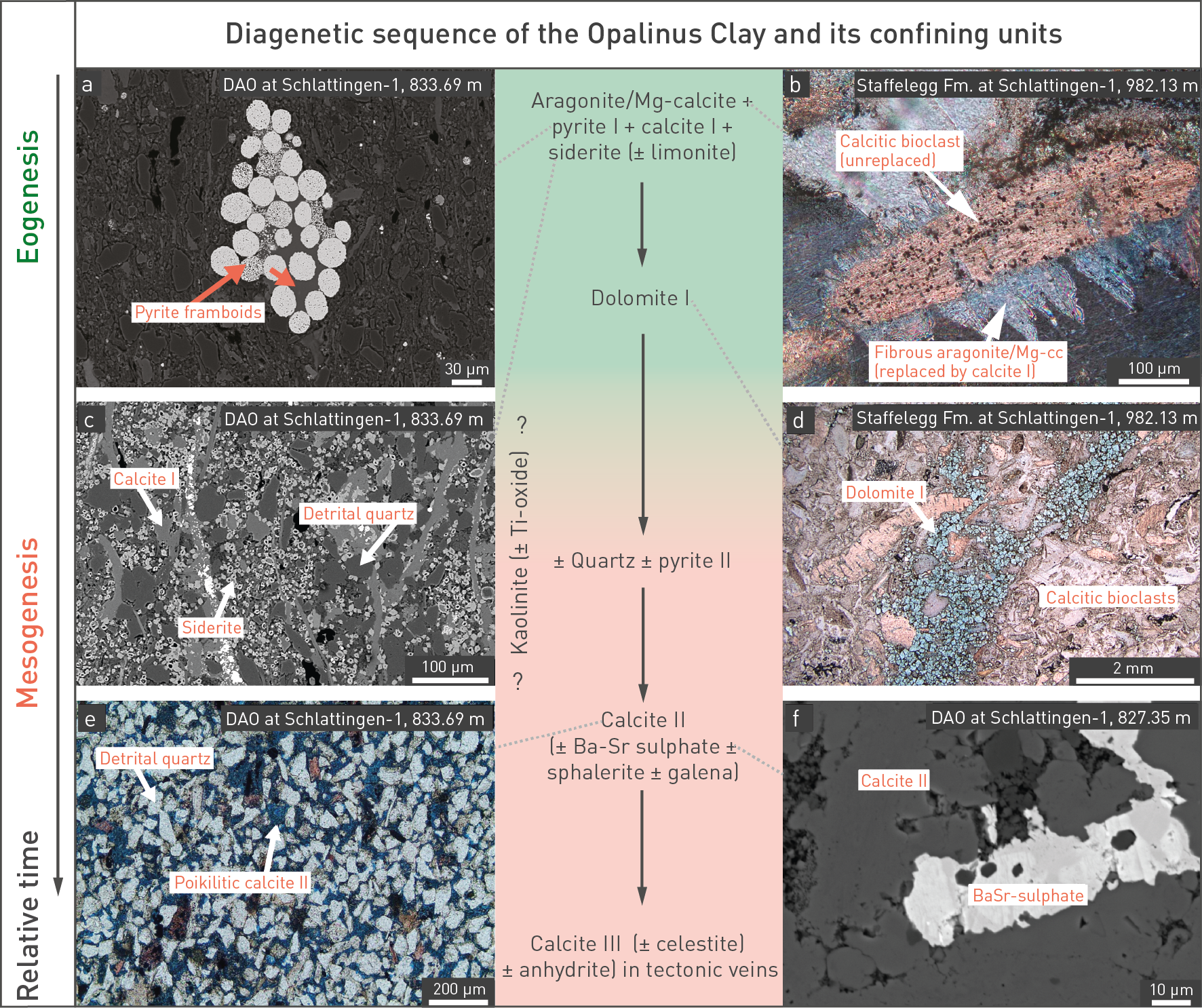After deposition on the seafloor, sediments were compacted during burial (Chapter 3, Fig. 3‑4) and affected by dissolution – precipitation reactions that influenced the mineralogical composition and porosity. These coupled processes caused cementation, affected the pore-size distribution and resulted in a modification of the initial (typically marine) porewater. Fig. 5‑7 provides a summary of the diagenetic evolution of the Opalinus Clay and its confining units based on the summary of Mazurek & Aschwanden (2020). Mineralisation in veins is described separately in Section 4.7.
The effects of early diagenesis (eogenesis), i.e. processes that occur within the first 100 m of burial, are quantitatively particularly important and mainly include the precipitation of aragonite/ Mg-calcite, pyrite I, siderite, calcite I and dolomite I (Fig. 5‑7). The precipitation of framboidal pyrite I and dolomite I affected all lithologies, including those that are clay-mineral-rich. In contrast, precipitation of aragonite/Mg-calcite and calcite I only occurred in areas rich in bioclastic material whose early diagenetic dissolution provided the solutes for pore-occluding cement precipitation. Siderite was mainly detected in the Opalinus Clay. Note that, from a quantitative perspective, diagenetic cements in the clay-rich matrix of the Opalinus Clay are only minor. Later cements related to burial diagenesis (mesogenesis), such as authigenic quartz and poikilitic calcite II, are more strongly expressed in silty/calcareous lithologies but only weakly in the clay-rich bulk of the rock. Diagenetic celestite and Ba-Sr sulphate have been detected by conventional transmitted light microscopy in both the Opalinus Clay and in the confining units. They mainly occur as fillings of interstices and as xenomorphic, fibrous cement in the rock matrix (Fig. 5‑7). It was argued that the solutes of these cements were supplied by dissolution of bioclasts (Lerouge et al. 2014).

Fig. 5‑7:Diagenetic minerals and their relative temporal sequence of precipitation in the Opalinus Clay and its confining units in Northern Switzerland
Modified after Mazurek & Aschwanden (2020): (a) Agglomerated framboids of pyrite. (b) Blocky (Fe-)calcite I replacing early fibrous aragonite/Mg-calcite cements in bioclast-rich zones. (c) Siderite concretion in a silty lens cemented with calcite II. (d) Dolomite I in a bioclast-rich zone. (e) Poikilitic calcite II cementing a silty lens. (f) Ba-Sr sulphate filling residual intergrain pore space after cementation by calcite II (a), (c), (f): Scanning electron microscope backscattered electron image (SEM-BSE); (b), (d), €: transmitted light microscopy). All photos from Mazurek & Aschwanden (2020) and Wersin et al. (2013). DAO: Dogger Group above Opalinus Clay.
There are no major systematic differences in the diagenetic cements and their relative timing over the study area, and no evident distinctions between the Opalinus Clay and the confining units can be made except for the fact that diagenetic effects are quantitatively more strongly expressed in the latter.
Implications for porosity and pore-size distribution in the Opalinus Clay: Based on the spatial homogeneity of diagenetic effects and the regionally consistent occurrence of different subunits, porosity and pore-size distribution can be considered to depend mainly on the maximum burial depth and on the current depth (i.e. the degree of uplift and decompaction). This implies that corresponding data are transferrable among sites with comparable burial and uplift histories.
Implications for porewater chemistry of the Opalinus Clay: As the inventory of detrital and diagenetic minerals present in the Opalinus Clay does not vary over the study area, it can be concluded that the mechanisms by which the rock controls the chemical composition of the porewater are regionally constant and can be treated in one single porewater model.

